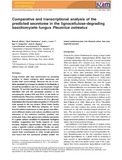Mostrar el registro sencillo del ítem
Comparative and transcriptional analysis of the predicted secretome in the lignocellulose-degrading basidiomycete fungus Pleurotus ostreatus
| dc.creator | Alfaro Sánchez, Manuel | es_ES |
| dc.creator | Castanera Andrés, Raúl | es_ES |
| dc.creator | Lavín Trueba, José Luis | es_ES |
| dc.creator | Oguiza Tomé, José Antonio | es_ES |
| dc.creator | Ramírez Nasto, Lucía | es_ES |
| dc.creator | Pisabarro de Lucas, Gerardo | es_ES |
| dc.date.accessioned | 2020-09-22T07:53:19Z | |
| dc.date.available | 2020-09-22T07:53:19Z | |
| dc.date.issued | 2016 | |
| dc.identifier.issn | 1462-2920 | |
| dc.identifier.uri | https://hdl.handle.net/2454/38220 | |
| dc.description.abstract | Fungi interact with their environment by secreting proteins to obtain nutrients, elicit responses and modify their surroundings. Because the set of proteins secreted by a fungus is related to its lifestyle, it should be possible to use it as a tool to predict fungal lifestyle. To test this hypothesis, we bioinformatically identified 538 and 554 secretable proteins in the monokaryotic strains PC9 and PC15 of the white rot basidiomycete Pleurotus ostreatus. Functional annotation revealed unknown functions (37.2%), glycosyl hydrolases (26.5%) and redox enzymes (11.5%) as the main groups in the two strains. When these results were combined with RNA‐seq analyses, we found that the relative importance of each group was different in different strains and culture conditions and the relevance of the unknown function proteins was enhanced. Only a few genes were actively expressed in a given culture condition in expanded multigene families, suggesting that family expansi on could increase adaptive opportunities rather than activity under a specific culture condition. Finally, we used the set of P. ostreatus secreted proteins as a query to search their counterparts in other fungal genomes and found that the secretome profiles cluster the tested basidiomycetes into lifestyle rather than phylogenetic groups. | en |
| dc.description.sponsorship | This work was supported by funds from the project AGL2011‐30495 of the Spanish National Research Plan, by additional institutional support from the Public University of Navarre, and by the Office of Science of the U.S. Department of Energy under Contract No. DE‐AC02‐05CH11231 (work conducted by the U.S. Department of Energy Joint Genome Institute). JLL is supported by the Basque Country Government (Etortek Research Programs 2011/2014) and from the Innovation Technology Dept. of Bizkaia. | en |
| dc.format.extent | 17 p. | |
| dc.format.mimetype | application/pdf | en |
| dc.language.iso | eng | en |
| dc.publisher | Wiley | en |
| dc.publisher | Society for Applied Microbiology | en |
| dc.relation.ispartof | Environmental Microbiology, 2016, 18(12), 4710-4726 | en |
| dc.rights | © 2016 The Authors. This is an open access article under the terms of the Creative Commons Attribution License, which permits use, distribution and reproduction in any medium, provided the original work is properly cited. | en |
| dc.rights.uri | http://creativecommons.org/licenses/by/4.0/ | |
| dc.subject | Fungi | en |
| dc.subject | Pleurotus ostreatus | en |
| dc.subject | Protein secretions | en |
| dc.title | Comparative and transcriptional analysis of the predicted secretome in the lignocellulose-degrading basidiomycete fungus Pleurotus ostreatus | en |
| dc.type | info:eu-repo/semantics/article | en |
| dc.type | Artículo / Artikulua | es |
| dc.contributor.department | Producción Agraria | es_ES |
| dc.contributor.department | Nekazaritza Ekoizpena | eu |
| dc.rights.accessRights | info:eu-repo/semantics/openAccess | en |
| dc.rights.accessRights | Acceso abierto / Sarbide irekia | es |
| dc.identifier.doi | 10.1111/1462-2920.13360 | |
| dc.relation.projectID | info:eu-repo/grantAgreement/MICINN//AGL2011-30495/ES/ | en |
| dc.relation.publisherversion | https://doi.org/10.1111/1462-2920.13360 | |
| dc.type.version | info:eu-repo/semantics/publishedVersion | en |
| dc.type.version | Versión publicada / Argitaratu den bertsioa | es |
| dc.contributor.funder | Universidad Pública de Navarra / Nafarroako Unibertsitate Publikoa | es |



